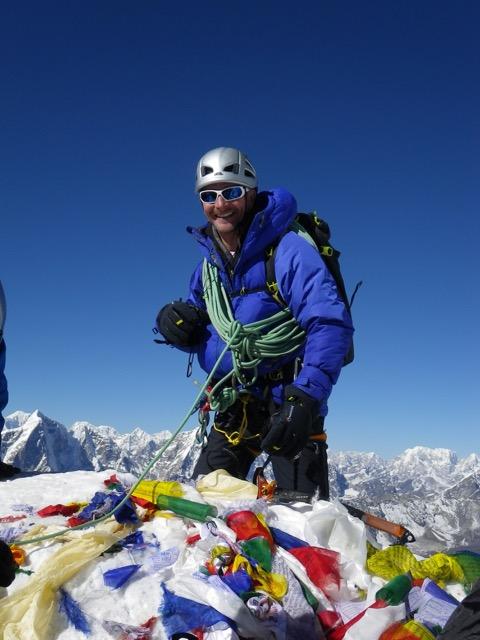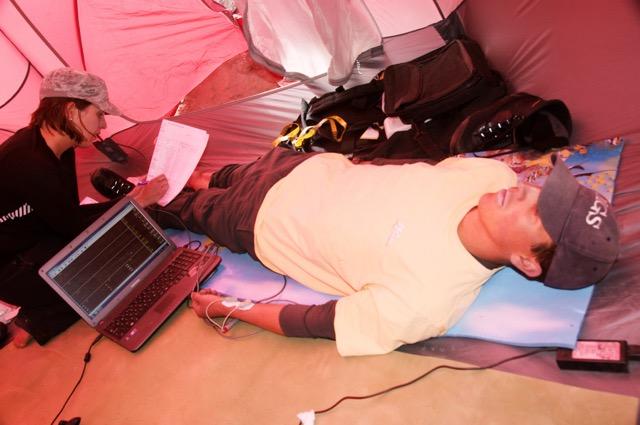 by Commander Adrian Mellor
by Commander Adrian Mellor
At high altitude there is a reduced pressure of oxygen in the atmosphere which results in very significant physiological changes in the body. The lack of oxygen can lead to Acute Mountain Sickness (AMS), a collection of symptoms not dissimilar to a hangover and the more serious and potentially fatal conditions of high altitude pulmonary or cerebral oedema. As trekking and mountaineering in this environment generally involves strenuous physical activity this places a great stress on the body which limits the amount of physical workload that can be performed and the ability to recover.
 There has been increasing interest in analysis of heart rate variability (HRV), as more sophisticated and portable equipment (such as ithlete) has become available, allowing its’ assessment under field conditions. Until this technology became available HRV had to be measured over prolonged periods of time (at least 15 minutes) and analysis was complex making it impractical as a daily monitor during a climbing expedition.
There has been increasing interest in analysis of heart rate variability (HRV), as more sophisticated and portable equipment (such as ithlete) has become available, allowing its’ assessment under field conditions. Until this technology became available HRV had to be measured over prolonged periods of time (at least 15 minutes) and analysis was complex making it impractical as a daily monitor during a climbing expedition.
Changes in HRV with high altitude exposure may alter with the physical and cardiovascular adaptations to exercise at high altitude. HRV involves analysis of R-R intervals on an ECG and relates to severity of and recovery from cardiac disease (European task group, 1996). In athletes a decreasing HRV has been shown to indicate the onset of overtraining syndrome (Mourot, Bouhaddi et al. 2004) and an increase to correlate with the improvement in athletic performance (Manzi, Castagna et al. 2009). There is a very little data relating to HRV at high altitude but what is published is intriguing and suggests that HRV may be a useful test to perform. The studies published to date have suggested that HRV changes at lower altitudes predict AMS at higher altitudes (Karinen, Uusitalo et al. 2012) or that HRV increases with time at high altitude (Bhaumik, Dass et al. 2013).
HRV during the course of a trek has not been published. Recently developed applications that can working with tablets or smartphones (such as ithlete) make the monitoring of HRV straightforward for lay persons and monitoring during a trek practicable. The fact that there are no significant differences between the electrocardiograph and ithlete derived root mean square of successive R-R interval values (p > 0.05) and the correlation was near perfect (r = 0.99, p < 0.001) (Flatt and Esco 2013) at sea level suggests it should be useful at HA and may prevent debilitating illness, allowing individuals to modify their daily activity to enable greater recovery.
 During February and March 2015 we are conducting a trek to Dhaulagiri in western Nepal. This is a spectacular trek close to two giant mountains (Dhaulagiri and Annapurna) and takes around two weeks. The route climbs gently at lower altitudes before climbing steeply to two passes above 5000m before descending steeply back towards habitation. Participants in the trek will be asked to perform daily HRV measurements with ithlete which will be compared to another ECG based measure of HRV as well as recording symptoms of AMS and physical exertion. We hope that this simple way of recording HRV will demonstrate adequate recovery from the previous days trek and have practical utility in the early detection of illness (AMS).
During February and March 2015 we are conducting a trek to Dhaulagiri in western Nepal. This is a spectacular trek close to two giant mountains (Dhaulagiri and Annapurna) and takes around two weeks. The route climbs gently at lower altitudes before climbing steeply to two passes above 5000m before descending steeply back towards habitation. Participants in the trek will be asked to perform daily HRV measurements with ithlete which will be compared to another ECG based measure of HRV as well as recording symptoms of AMS and physical exertion. We hope that this simple way of recording HRV will demonstrate adequate recovery from the previous days trek and have practical utility in the early detection of illness (AMS).
References
Bhaumik, G., D. Dass, D. Bhattacharyya, Y. K. Sharma and S. B. Singh (2013). “Heart rate variabilty changes during first week of acclimatization to 3500 m altitude in Indian military personnel.” Indian J Physiol Pharmacol 57(1): 16-22.
Flatt, A. A. and M. R. Esco (2013). “Validity of the ithlete Smart Phone Application for Determining Ultra-Short-Term Heart Rate Variability.” J Hum Kinet 39: 85-92.
Karinen, H. M., A. Uusitalo, H. Vaha-Ypya, M. Kahonen, J. E. Peltonen, P. K. Stein,
- Viik and H. O. Tikkanen (2012). “Heart rate variability changes at 2400 m altitude predicts acute mountain sickness on further ascent at 3000-4300 m altitudes.” Front Physiol 3: 336.
Manzi, V., C. Castagna, E. Padua, M. Lombardo, S. D’Ottavio, M. Massaro, M. Volterrani and F. Iellamo (2009). “Dose-response relationship of autonomic nervous system responses to individualized training impulse in marathon runners.” Am J Physiol Heart Circ Physiol 296(6): H1733-1740.
Mourot, L., M. Bouhaddi, S. Perrey, S. Cappelle, M. T. Henriet, J. P. Wolf, J. D. Rouillon and J. Regnard (2004). “Decrease in heart rate variability with overtraining: assessment by the Poincare plot analysis.” Clin Physiol Funct Imaging 24(1): 10-18.

Update – the results have now been published and you can find the paper here:
http://eprints.leedsbeckett.ac.uk/2234/